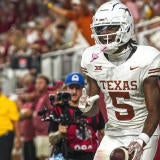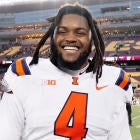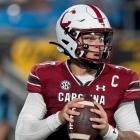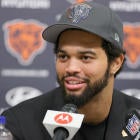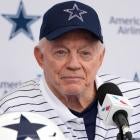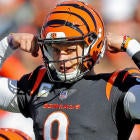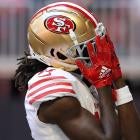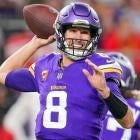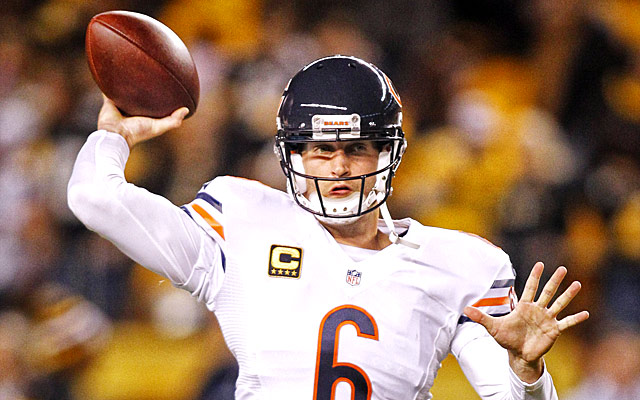
New storylines emerge every week. Some are reasonable, most are not. "This Week in Overreactions" focuses on the latter. Those items that offer a cursory "How do you do?" as they blow past reality straight for THIS IS THE MOST AMAZING THING EVER! We're here to keep everything in perspective. Questions, comments, casserole ideas? Hit us up on Twitter at @ryanwilson_07.
'Jay Cutler is finally a legit franchise QB!'
We've seen this movie before. Jay Cutler starts strong and silences his critics for the first month or so. Then some combination of abominable play-calling, poor decision-making on Cutler's part and piss-poor pass-blocking conspire to sink a once-promising season. Except this time, for the first time, Cutler isn't at the mercy of Mike Martz or Mike Tice, but finds himself in the capable hands of first-year coach Marc Trestman, whom Cris Collinsworth actually referred to as "The Quarterback Whisperer" during Sunday's pregame show.
And for the first three series against the Steelers, Cutler looked every bit the efficient franchise QB we've come to expect from Peyton Manning and Drew Brees. Quick drops, decisive reads and crisp passes highlighted the first quarter, all while Pittsburgh's defense searched for ways to get to a quarterback who was sacked 38 times last season (but only twice in the first two games of 2013).
A prime example came on the first drive. With the Bears facing a 3rd-and-3 from their 40, the Steelers overloaded the right side in an effort to confuse a young offensive line, sending Troy Polamalu on a blitz behind a stunting LaMarr Woodley (image 1 below). Polamalu, who first faked like he was dropping into coverage, had a clear path to Cutler … except that the Bears' quarterback had the ball out of his before Polamalu could get near him, hitting Alshon Jeffery for an eight-yard gain and a first down (image 2).


Trestman deserves a lot of credit for having a calming influence on his QB. Cutler is playing with patience and poise.
— Daniel Jeremiah (@MoveTheSticks) September 23, 2013
But here's the thing: Can this last? Can Efficient Jay continue to be, well, efficient?
In the past, we've seen Cutler go off script when things weren't working and it usually led to more sacks, more turnovers and, ultimately, more losses. But again, that might have more to do with Martz and Tice, right? Cutler had success with Mike Shanahan in Denver, and he looks to be a completely different player under Trestman.
Even when the Bears' offense stalled in the second and third quarters of Sunday's game in Pittsburgh, Cutler never came close to throwing an interception, and never put himself in a situation that had Bears' fans thinking, "This is going to end badly." Instead, Cutler jump-started a fourth-quarter drive by trucking Steelers safety Robert Golden on a 13-yard scramble on 3rd-and-10 (GIF via Larry Brown Sports).

Three plays later and facing 3rd-and-12, Cutler calmly found Brandon Marshall for a 41-yard gain, and two plays after that, threw a laser in the back of the end zone to Earl Bennett to give the Bears a 34-23 lead and effectively put the game out of reach.
That's the Jay Cutler Bears' fans have been patiently waiting for. And maybe that's where Trestman's true value comes in. Yes, he has Cutler trusting the system, something the quarterback almost certainly wasn't doing under Martz or Tice. (And, really, who's blaming him for that?) But Trestman also has Cutler entering the fourth quarter healthy.
In previous seasons, Cutler would spend the first 45 minutes getting his brains scrambled by mostly unblocked defensive ends and linebackers. There's something to be said for your quarterback having his wits about him during a critical late-game drive.
So again, our original question: Can this last?
Since Cutler arrived in 2009, here's how the the Bears have started -- and finished:
2009: started 3-1, finished 7-9
2010: started 3-0, finished 11-5 (made the playoffs for the only time in Cutler's tenure)
2011: started 1-2, finished 8-8*
2012: started 7-1, finished 10-6
* The Bears were 7-3 with Cutler, who missed the final six weeks of the 2011 regular season with a thumb injury.
So you can see why we're not quite ready to commandeer the Jay Cutler bandwagon. But despite the early returns, there's more encouraging news, via ProFootballFocus.com.
Through the first two games, from the time Cutler takes the snap until the ball leaves his hand takes, on average, 2.7 seconds. That ranks 16th among starting quarterbacks.
But here's where things get interesting: When Cutler gets the ball out in 2.5 seconds or less, he completes 74 percent of his throws and his passer rating is 102.9. When it's 2.6 seconds or more, he completion percentage drops to 63.0 and his passer rating falls to 87.7.
Last season, Cutler averaged 2.79 seconds to throw. However, for balls that came out in less than 2.5 seconds, his completion percentage was 63.5 and his passer rating was 84.5. For 2.6 seconds or more, his completion percentage was 52.4 and his passer rating was 77.0.
The takeaway: Trestman has had an immediate impact on Cutler's performance. Also not hurting: An offensive line playing extremely well, and a quarterback with new-found confidence.
"This could have been a very frustrating night," Trestman said Sunday after the Bears cruised to a 40-23 win over the Steelers. "There were some people in [Cutler's] face. He had to scramble. But we knew going in that it wasn't going to be simple. It wasn't going to be clean on every play, and we tried to give him the quick stuff and get it out of his hands."
"We're preaching ball security a lot," Cutler said. "It was that type of game. To get up quickly like that (the Bears led 24-3 in the 2nd quarter), we didn't want to give them anything easy and force the ball. We didn't want to get them in position in our territory. Just be patient."
Yes, the Bears are 3-0, and yes they're alone in first place in the NFC North a game up on the Lions and two games clear of the Packers. For now, though, we remain cautiously optimistic. Chicago travels to Detroit Sunday and then hosts the Saints in Week 5. If they emerge from those games looking like the same team that steamrolled Pittsburgh, then we'll be all-in on Cutlermania.
'Trent Richardson really improves the Colts' running game!'
It's hard to argue that landing one of the NFL's best young running backs is ever a bad idea, but the Colts gave up a 2014 first-round pick for Trent Richardson, whom the Browns decided wasn't an integral part of their rebuilding effort.
We understand the logic: Richardson will keep defenses honest, meaning more big plays for quarterback Andrew Luck. And the more success Luck and the passing game have, the more running lanes that will be available to Richardson when he does get the rock.
In theory, this makes sense. Reality could be a different story.
1. For all the talk that Richardson will no longer face eight-man fronts because of Luck's passing ability, consider this, via ProFootballFocus.com: He only saw eight men in the box on 18 percent of his rushing attempts last season.
2. The Colts running game wasn't in need of fixing. Yes, Vick Ballard is lost for the season, and Ahmad Bradshaw has struggled to stay healthy, but through the first two weeks, Indianapolis had the league's second-ranked rushing attack, according to Football Outsiders, behind the Eagles. These numbers will only improve after Bradshaw rushed for 95 yards on 19 carries, and scored a touchdown.
3. We've been beating this drum for years, but high-price running backs rarely justify the cost. Back in August 2011, before the Titans caved and paid Chris Johnson, we wrote that the shelf life for a top-flight running back is remarkably short. A study by Doug Drinin of Pro-Football-Reference.com found that running backs usually decline by age 28, wide receivers by age 30 and quarterbacks by age 32.
Then there's the research by FootballOutsiders.com, which suggests that rushing success is more dependent on the offensive line, but pass protection is more dependent on the quarterback. Put differently: teams can find productive running backs -- no matter when they were drafted (or if they were drafted at all) or how much they're making -- if a good offensive line is already in place. A great running back, in general, is wasted on a mediocre offensive line.
We'll have to see how this plays out in Indy, where the defense could certainly benefit from a playmaker that now won't come via a 2014 first-round pick.
'See, the Browns aren't tanking the season!'
Remember six days ago, when the Browns traded Trent Richardson to the Colts and fans reflexively assumed the position? Another lost season, this one decided by mid-September, and all that was left was to tank the final 14 games because, well, these are the Browns.
Except that maybe this time things really could be different. Third-string quarterback Brian Hoyer started last Sunday against the Vikings, and played like the organization had hoped Brandon Weeden would. Cleveland is now 1-2, ahead of Pittsburgh in the AFC North, and there will be no tanking in this team's future.
Big part of Browns pass protecting success yesterday? Brian Hoyer average time to throw 2.4 seconds. Brandon Weeden? 3.1 in first 2 games
— Pro Football Focus (@PFF) September 23, 2013
"We have to earn their (fans) belief and trust and the decisions we're going to make as a group and I don't expect them to trust that until we prove to them that trust is well placed," team president Joe Banner said after shipping Richardson to Indy. "So, I understand the skepticism for now, but we have to do what we think is right and move the franchise forward."
And what is right involves finding a legit franchise quarterback.
Look at the words hanging above the #Browns war room, via @RuiterWrongFAN pic.twitter.com/W2Zhzcaw46
— Marc Sessler (@MarcSesslerNFL) September 19, 2013
That's the Browns' draft board. And above the television on the left are the words: "The Critical Path to the Super Bowl, We will be BOLD, We will have a a CHAMPIONSHIP LEVEL QB."
And now, with the Colts' first-round pick to go along with four other picks the Browns have in the first three rounds of the 2014 draft, the organization has the fire power to get whomever they decide fits the description of a "championship level quarterback."
And it doesn't require any tanking between now and then. (We've cast our early vote for Johnny Manziel.)
'The Jags would be a competitive SEC team!'
It's been almost a year since South Carolina coach Steve Spurrier proclaimed that the 2012 Alabama Crimson Tide could compete in the NFL. We seem to have these conversations every few months, but even though Alabama had nine players from that team drafted in April -- including three first-rounders (Dee Milliner, Chance Warmack, D.J. Fluker) -- the reality is that NFL teams have elite players at every position.
But what about the 2013 Jacksonville Jaguars? How would they fare in the SEC?
We're half-kidding because, presumably, the same logic above holds: They're an NFL team with elite players at every position. Except that couldn't be further from the truth.
We get it, this team is in full-on "blow it up and start over" mode. And we applaud new general manager David Caldwell for facing up to that reality, even if he didn't create it (thanks, Gene Smith!). But this outfit ranks last in every conceivable category. In three games, they've been outscored 28-92, most recently a 45-17 shellacking in Seattle where they didn't come close to covering the 19.5-point spread.
Field level. Behind #Jaguars bench... This guy. His sign... I maneuvered my way down to get this shot... pic.twitter.com/8h7FiUCWIq
— Hopeless Honky (@BoldCityCap) September 22, 2013
Decisions like this certainly go a long way in explaining Jacksonville's current predicament. We'll repeat what we said after the Jags used a third-round pick on punter Brian Anger:
No one doubts that Anger has starter ability. The problem: the Jags lost 11 times last season and it wasn't because they didn't have a top-flight punter. And this isn't the first time in recent draft history that Jacksonville drafted a punter. In 2007, they selected Adam Podlesh in the fourth round, and thought so much of him that they let him walk after the 2010 season. He signed with the Bears and played well in 2011. The lesson: a team with myriad roster needs shouldn't be preoccupied with landing the "best" punter when starters can regularly be found after the draft.
And if your argument is some form of: "See, you admit that Anger will play and he'll have the important role of changing field position. It's not a bad pick!" We'd like to mention another means of changing field position: DRraft players that help the offense get first downs. Like, say, Russell Wilson.
None of this is Caldwell's fault, of course, but it's the mess he's inherited. It's not all bad news, though. There's this from SBNation's Matt Ufford:
At least Jacksonville's athletic department gets $500K from Seattle for this.
— Matt Ufford (@mattufford) September 22, 2013









